engine SUBARU LEGACY 2005 4.G Repair Manual
[x] Cancel search | Manufacturer: SUBARU, Model Year: 2005, Model line: LEGACY, Model: SUBARU LEGACY 2005 4.GPages: 627, PDF Size: 6.42 MB
Page 378 of 627
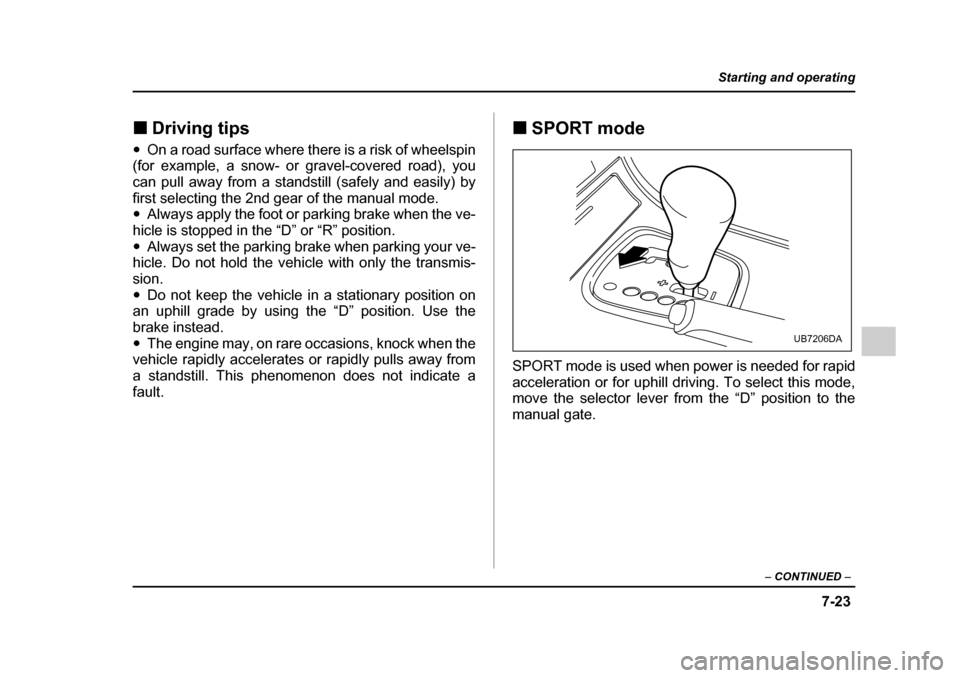
7-23
Starting and operating
– CONTINUED –
!Driving tips
" On a road surface where there is a risk of wheelspin
(for example, a snow- or gravel-covered road), you
can pull away from a standstill (safely and easily) by
first selecting the 2nd gear of the manual mode. " Always apply the foot or parking brake when the ve-
hicle is stopped in the “D” or “R” position. " Always set the parking brake when parking your ve-
hicle. Do not hold the vehicle with only the transmis-
sion." Do not keep the vehicle in a stationary position on
an uphill grade by using the “D” position. Use the
brake instead." The engine may, on rare occasions, knock when the
vehicle rapidly accelerates or rapidly pulls away from
a standstill. This phenomenon does not indicate afault. !
SPORT mode
SPORT mode is used when power is needed for rapid
acceleration or for uphill driving. To select this mode,
move the selector lever from the “D” position to the
manual gate.
UB7206DA
Page 379 of 627
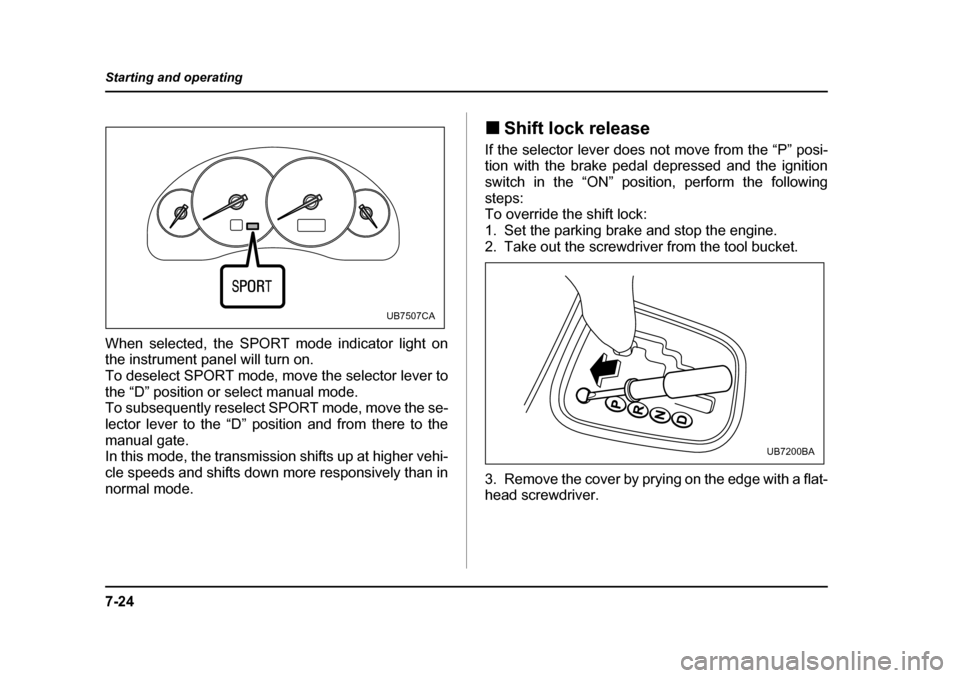
7-24
Starting and operating
When selected, the SPORT mode indicator light on
the instrument panel will turn on.
To deselect SPORT mode, move the selector lever to
the “D” position or select manual mode.
To subsequently reselect SPORT mode, move the se-
lector lever to the “D” position and from there to the
manual gate.
In this mode, the transmission shifts up at higher vehi-
cle speeds and shifts down more responsively than in
normal mode.
!
Shift lock release
If the selector lever does not move from the “P” posi-
tion with the brake pedal depressed and the ignition
switch in the “ON” position, perform the followingsteps:
To override the shift lock:
1. Set the parking brake and stop the engine.
2. Take out the screwdriver from the tool bucket.
3. Remove the cover by prying on the edge with a flat-
head screwdriver.
UB7507CA
UB7200BA
Page 380 of 627
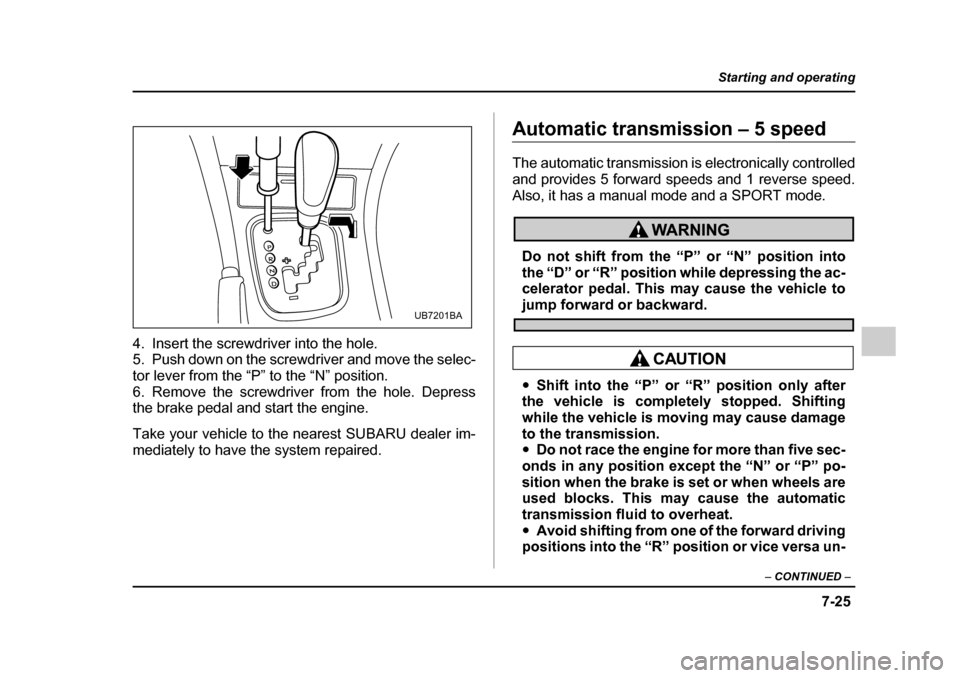
7-25
Starting and operating
– CONTINUED –
4. Insert the screwdriver into the hole.
5. Push down on the screwdriver and move the selec-
tor lever from the “P” to the “N” position.
6. Remove the screwdriver from the hole. Depress
the brake pedal and start the engine.
Take your vehicle to the nearest SUBARU dealer im-
mediately to have the system repaired.
Automatic transmission – 5 speed
The automatic transmission is electronically controlled
and provides 5 forward speeds and 1 reverse speed.
Also, it has a manual mode and a SPORT mode.
Do not shift from the “P” or “N” position into
the “D” or “R” position while depressing the ac-
celerator pedal. This may cause the vehicle to
jump forward or backward.
"Shift into the “P” or “R” position only after
the vehicle is completely stopped. Shifting
while the vehicle is moving may cause damage
to the transmission. " Do not race the engine for more than five sec-
onds in any position except the “N” or “P” po-
sition when the brake is set or when wheels are
used blocks. This may cause the automatic
transmission fluid to overheat." Avoid shifting from one of the forward driving
positions into the “R” position or vice versa un-
UB7201BA
Page 381 of 627
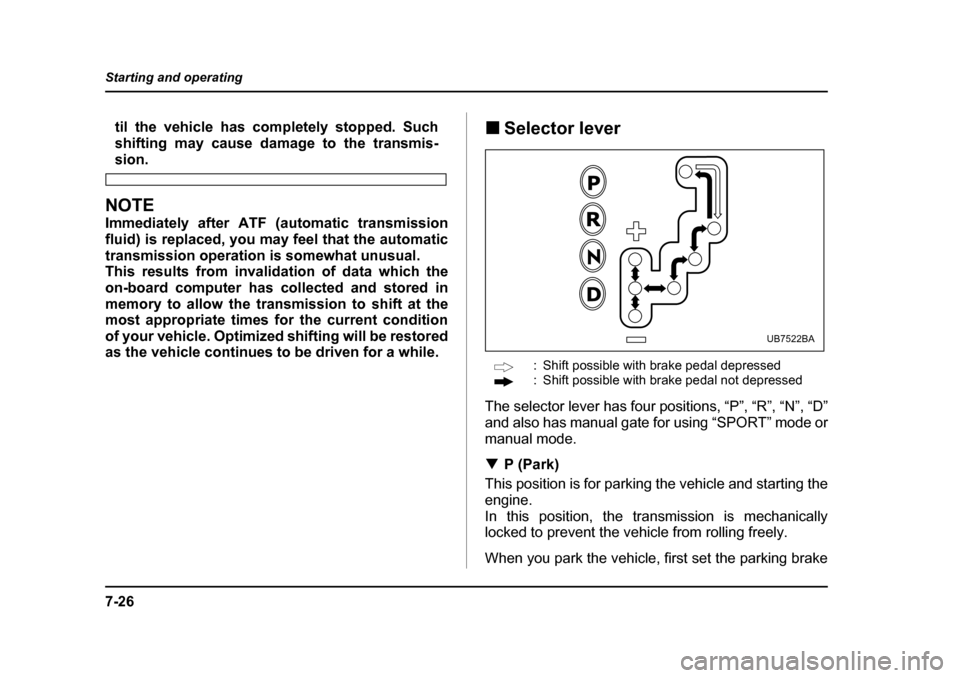
7-26
Starting and operating
til the vehicle has completely stopped. Such
shifting may cause damage to the transmis-
sion.
NOTE
Immediately after ATF (automatic transmission
fluid) is replaced, you may feel that the automatic
transmission operation is somewhat unusual.
This results from invalidation of data which the
on-board computer has collected and stored inmemory to allow the transmission to shift at the
most appropriate times for the current condition
of your vehicle. Optimized shifting will be restored
as the vehicle continues to be driven for a while.
!
Selector lever
: Shift possible with brake pedal depressed
: Shift possible with brake pedal not depressed
The selector lever has four positions, “P”, “R”, “N”, “D”
and also has manual gate for using “SPORT” mode or manual mode. ! P (Park)
This position is for parking the vehicle and starting the
engine.
In this position, the transmission is mechanically
locked to prevent the vehicle from rolling freely.
When you park the vehicle, first set the parking brake
UB7522BA
Page 382 of 627
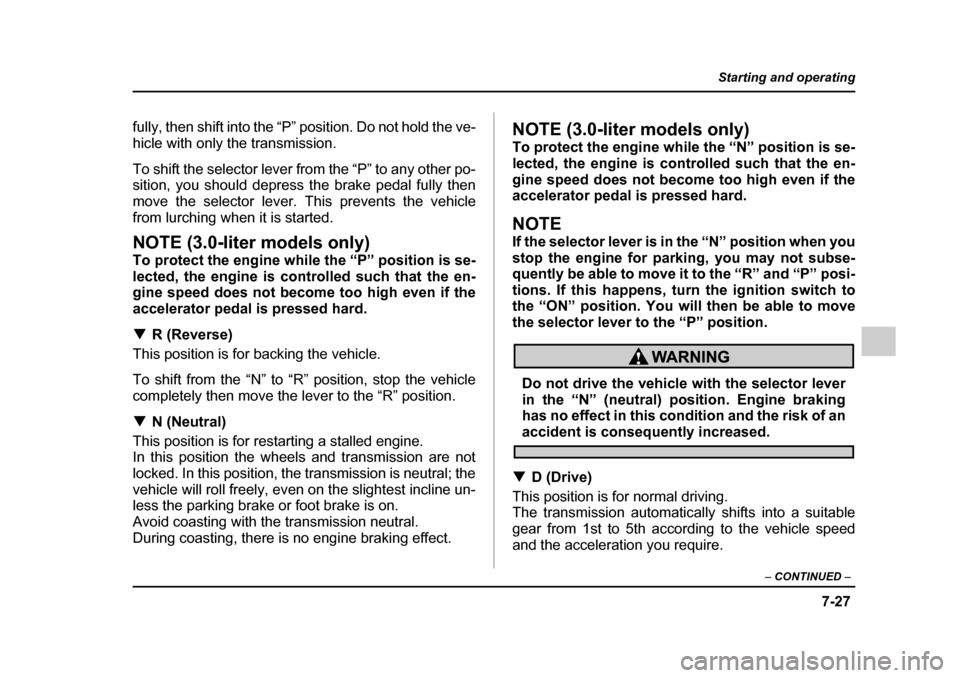
7-27
Starting and operating
– CONTINUED –
fully, then shift into the “P” position. Do not hold the ve-
hicle with only the transmission.
To shift the selector lever from the “P” to any other po-
sition, you should depress the brake pedal fully then
move the selector lever. This prevents the vehicle
from lurching when it is started.
NOTE (3.0-liter models only)
To protect the engine while the “P” position is se-
lected, the engine is controlled such that the en-
gine speed does not become too high even if the
accelerator pedal is pressed hard. !R (Reverse)
This position is for backing the vehicle.
To shift from the “N” to “R” position, stop the vehicle
completely then move the lever to the “R” position. ! N (Neutral)
This position is for restarting a stalled engine.
In this position the wheels and transmission are not
locked. In this position, the transmission is neutral; the
vehicle will roll freely, even on the slightest incline un-
less the parking brake or foot brake is on.
Avoid coasting with the transmission neutral.
During coasting, there is no engine braking effect.
NOTE (3.0-liter models only)
To protect the engine while the “N” position is se-
lected, the engine is controlled such that the en-
gine speed does not become too high even if the
accelerator pedal is pressed hard.
NOTE
If the selector lever is in the “N” position when you
stop the engine for parking, you may not subse-
quently be able to move it to the “R” and “P” posi-tions. If this happens, turn the ignition switch to
the “ON” position. You will then be able to move
the selector lever to the “P” position.
Do not drive the vehicle with the selector lever
in the “N” (neutral) position. Engine braking
has no effect in this condition and the risk of an
accident is consequently increased.
! D (Drive)
This position is for normal driving.
The transmission automatically shifts into a suitable
gear from 1st to 5th according to the vehicle speed
and the acceleration you require.
Page 383 of 627
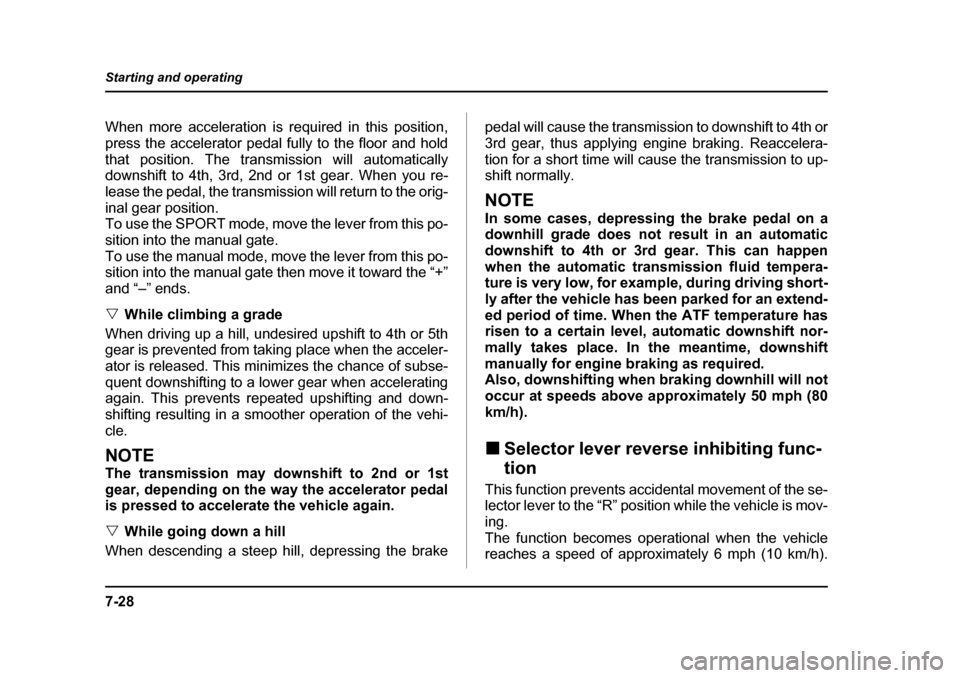
7-28
Starting and operating
When more acceleration is required in this position,
press the accelerator pedal fully to the floor and hold
that position. The transmission will automatically
downshift to 4th, 3rd, 2nd or 1st gear. When you re-
lease the pedal, the transmission will return to the orig-
inal gear position.
To use the SPORT mode, move the lever from this po-
sition into the manual gate.
To use the manual mode, move the lever from this po-
sition into the manual gate then move it toward the “+”
and “–” ends. "
While climbing a grade
When driving up a hill, undesired upshift to 4th or 5th
gear is prevented from taking place when the acceler-
ator is released. This minimizes the chance of subse-
quent downshifting to a lower gear when accelerating
again. This prevents repeated upshifting and down-
shifting resulting in a smoother operation of the vehi-cle.
NOTE
The transmission may downshift to 2nd or 1st
gear, depending on the way the accelerator pedal
is pressed to accelerate the vehicle again. " While going down a hill
When descending a steep hill, depressing the brake pedal will cause the transmission to downshift to 4th or
3rd gear, thus applying engine braking. Reaccelera-
tion for a short time will cause the transmission to up- shift normally.
NOTE
In some cases, depressing the brake pedal on a
downhill grade does not result in an automatic
downshift to 4th or 3rd gear. This can happen
when the automatic transmission fluid tempera-
ture is very low, for example, during driving short-
ly after the vehicle has been parked for an extend-
ed period of time. When the ATF temperature has
risen to a certain level, automatic downshift nor-
mally takes place. In the meantime, downshift
manually for engine braking as required.
Also, downshifting when braking downhill will not
occur at speeds above approximately 50 mph (80
km/h). !
Selector lever reverse inhibiting func- tion
This function prevents accidental movement of the se-
lector lever to the “R” position while the vehicle is mov-
ing.
The function becomes operational when the vehicle
reaches a speed of approximately 6 mph (10 km/h).
Page 387 of 627
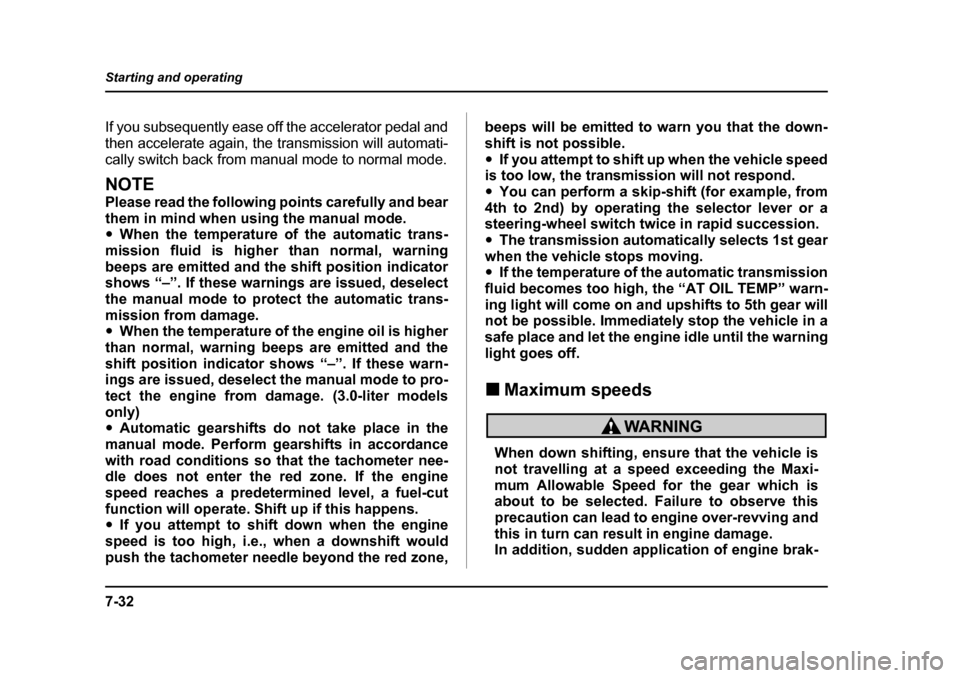
7-32
Starting and operating
If you subsequently ease off the accelerator pedal and
then accelerate again, the transmission will automati-
cally switch back from manual mode to normal mode.
NOTE
Please read the following points carefully and bear
them in mind when using the manual mode. "
When the temperature of the automatic trans-
mission fluid is higher than normal, warning
beeps are emitted and the shift position indicator
shows “–”. If these warnings are issued, deselect
the manual mode to protect the automatic trans-
mission from damage. " When the temperature of the engine oil is higher
than normal, warning beeps are emitted and the
shift position indicator shows “–”. If these warn-
ings are issued, deselect the manual mode to pro-
tect the engine from damage. (3.0-liter models
only) " Automatic gearshifts do not take place in the
manual mode. Perform gearshifts in accordance
with road conditions so that the tachometer nee-
dle does not enter the red zone. If the engine
speed reaches a predetermined level, a fuel-cut
function will operate. Shift up if this happens. " If you attempt to shift down when the engine
speed is too high, i.e., when a downshift would
push the tachometer needle beyond the red zone, beeps will be emitted to warn you that the down-
shift is not possible."
If you attempt to shift up when the vehicle speed
is too low, the transmission will not respond." You can perform a skip-shift (for example, from
4th to 2nd) by operating the selector lever or a
steering-wheel switch twice in rapid succession. " The transmission automatically selects 1st gear
when the vehicle stops moving. " If the temperature of the automatic transmission
fluid becomes too high, the “AT OIL TEMP” warn-
ing light will come on and upshifts to 5th gear will
not be possible. Immediately stop the vehicle in a
safe place and let the engine idle until the warning
light goes off. ! Maximum speeds
When down shifting, ensure that the vehicle is
not travelling at a speed exceeding the Maxi-
mum Allowable Speed for the gear which is
about to be selected. Failure to observe this
precaution can lead to engine over-revving and
this in turn can result in engine damage.
In addition, sudden application of engine brak-
Page 388 of 627

7-33
Starting and operating
– CONTINUED –
ing caused by down shifting when the vehicle is
travelling on a slippery surface can lead to
wheel locking; as a consequence, control of the
vehicle may be lost and the risk of an accident
increased.
The following tables show the maximum speeds that
are possible with each different gear.
When down shifting, it is important to confirm that the
current vehicle speed is not in excess of the Maximum
Allowable Speed of the gear which is about to be se-
lected. mph (km/h)
Never exceed posted speed limits.
NOTE " In order to prevent over-revving during acceler-
ation of the vehicle, the transmission will automat-
ically shift to the next highest gear if the Maximum
Allowable Speed for the current gear is exceeded. " Similarly, in order to prevent over-revving dur-
ing deceleration of the vehicle, the transmission
will remain in the current gear if the speed of the
vehicle is in excess of the Maximum Allowable
Speed for the gear to which the selector lever has
been moved. ! Driving tips
" On a road surface where there is a risk of wheelspin
(for example, a snow- or gravel-covered road), you
can pull away from a standstill safely and easily by first
selecting the 2nd gear of the manual mode. " Always apply the foot or parking brake when the ve-
hicle is stopped in the “D” or “R” position. " Always set the parking brake when parking your ve-
hicle. Do not hold the vehicle with only the transmis- sion. " Do not keep the vehicle in a stationary position on
an uphill grade by using the “D” position. Use the
brake instead. " The engine may, on rare occasions, knock when the
vehicle rapidly accelerates or rapidly pulls away from
Position 2.5-liter turbo models 3.0-liter
models
Except
OUTBACK OUTBACK
1 36 (59) 35 (57) 42 (68)
2 59 (92) 55 (90) 66 (107)
3 88 (142) 86 (139) 102 (165)
Page 390 of 627
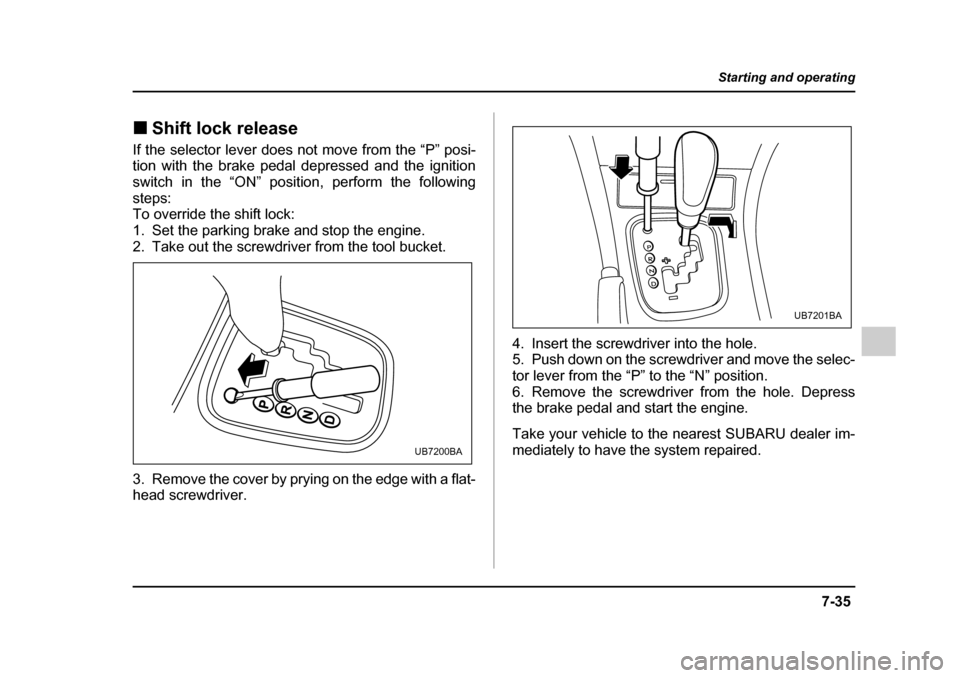
7-35
Starting and operating
– CONTINUED –
!Shift lock release
If the selector lever does not move from the “P” posi-
tion with the brake pedal depressed and the ignition
switch in the “ON” position, perform the following
steps:
To override the shift lock:
1. Set the parking brake and stop the engine.
2. Take out the screwdriver from the tool bucket.
3. Remove the cover by prying on the edge with a flat-
head screwdriver. 4. Insert the screwdriver into the hole.
5. Push down on the screwdriver and move the selec-
tor lever from the “P” to the “N” position.
6. Remove the screwdriver from the hole. Depress
the brake pedal and start the engine.
Take your vehicle to the nearest SUBARU dealer im-
mediately to have the system repaired.
UB7200BA
UB7201BA
Page 391 of 627
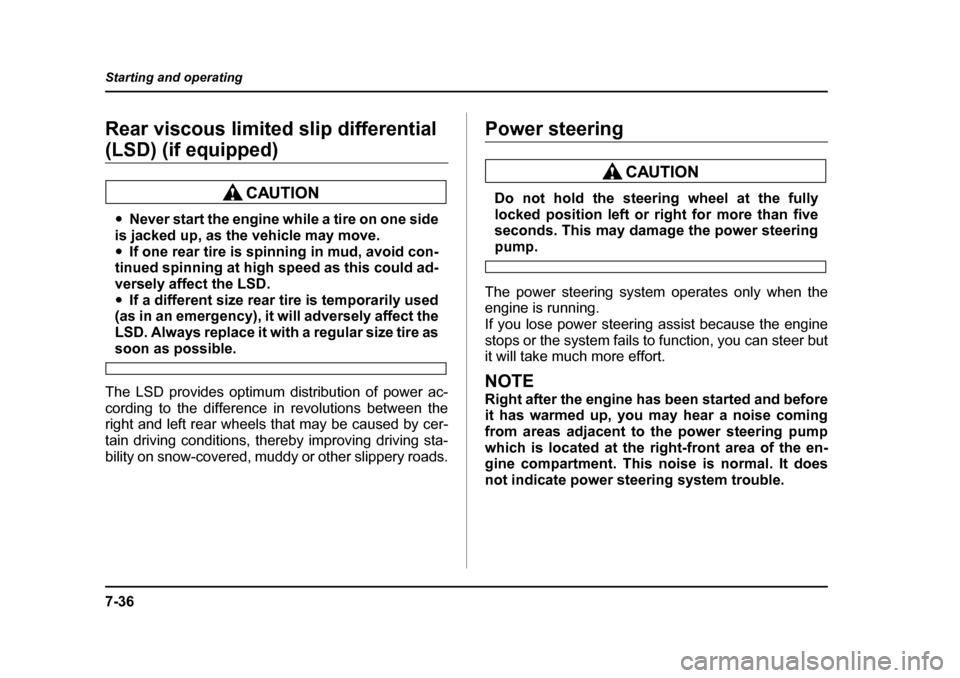
7-36
Starting and operating
Rear viscous limited slip differential
(LSD) (if equipped)
"
Never start the engine while a tire on one side
is jacked up, as the vehicle may move. " If one rear tire is spinning in mud, avoid con-
tinued spinning at high speed as this could ad-
versely affect the LSD. " If a different size rear tire is temporarily used
(as in an emergency), it will adversely affect the
LSD. Always replace it with a regular size tire as
soon as possible.
The LSD provides optimum distribution of power ac-
cording to the difference in revolutions between the
right and left rear wheels that may be caused by cer-
tain driving conditions, thereby improving driving sta-
bility on snow-covered, muddy or other slippery roads.
Power steering
Do not hold the steering wheel at the fully
locked position left or right for more than five
seconds. This may damage the power steering
pump.
The power steering system operates only when the
engine is running.
If you lose power steering assist because the engine
stops or the system fails to function, you can steer but
it will take much more effort.
NOTE
Right after the engine has been started and before
it has warmed up, you may hear a noise coming
from areas adjacent to the power steering pump
which is located at the right-front area of the en-
gine compartment. This noise is normal. It does
not indicate power steering system trouble.